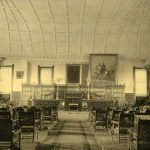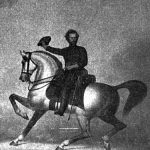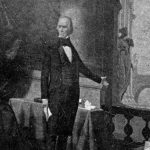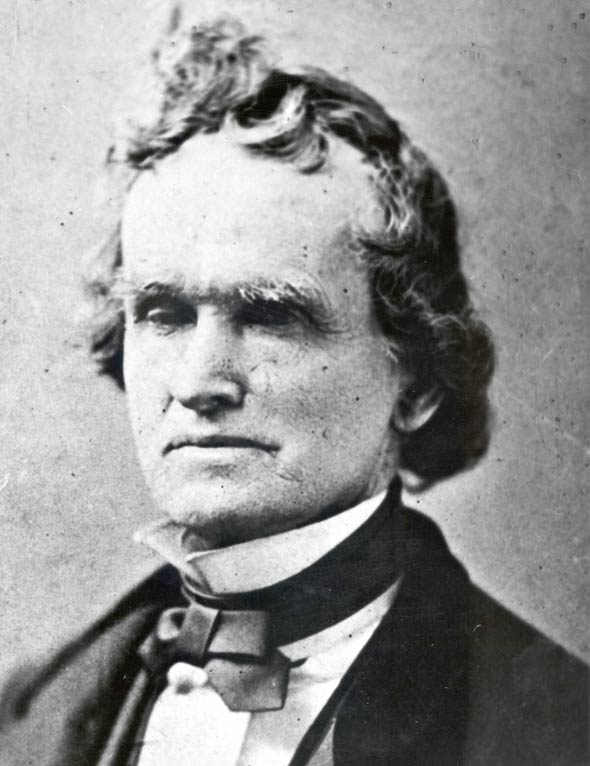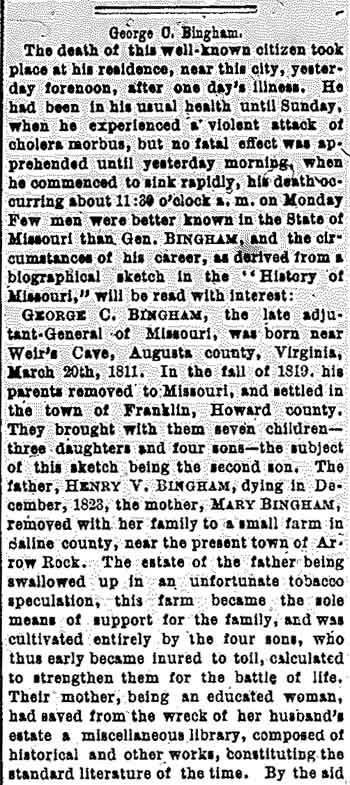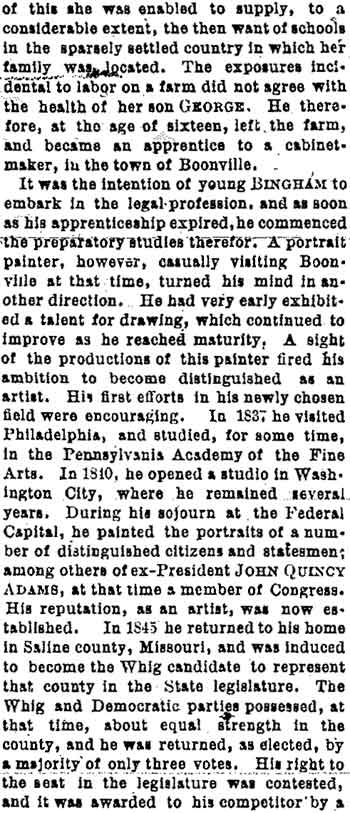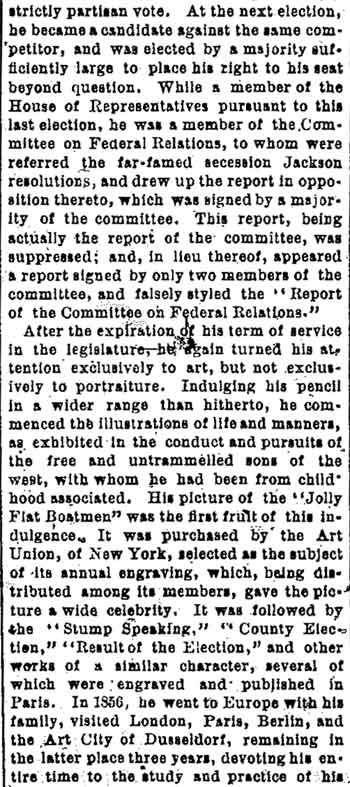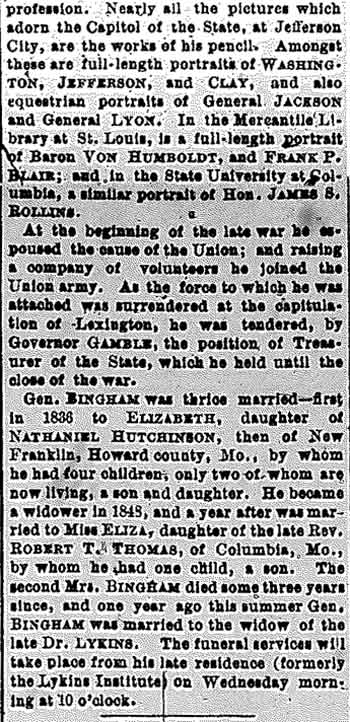
George Caleb Bingham

Introduction
George Caleb Bingham was a Missouri artist and politician. During his lifetime, he was known as “the Missouri Artist.” Painting his most significant pieces between 1845 and 1860, Bingham produced many remarkable drawings, portraits, landscapes, and scenes of social and political life on the frontier. He was also active in civic affairs and contributed to the political life of Missouri before and after the Civil War.
Early Years
George Caleb Bingham was born on March 20, 1811, in Augusta County, Virginia. He was the second of seven children born to Henry Vest and Mary Amend Bingham. Living on a large farm, George showed a strong interest in drawing at an early age. He supposedly drew on the sides of barns, fence posts, and the walls of the family mill. When George was seven, his father lost most of the family’s property to cover a friend’s debts. Homeless, George left Virginia with his parents, five siblings, his grandfather Matthias Amend, and the people they enslaved. They headed to Missouri to build a new life.
Settling in Missouri
George Bingham’s family settled in Franklin, a village on the banks of the Missouri River. It was the summer of 1819 and his parents were quick to contribute to their new community. His father opened an inn called the Square and Compass. He also started a tobacco factory, bought farmland, and became a civic leader. Bingham’s mother was an educated woman and soon started a school for girls, one of the first west of the Mississippi River.
When George was nine, a nationally known painter named Chester Harding came to Franklin to finish a portrait of Daniel Boone. George visited Harding’s make-shift studio and watched him paint the famous pioneer’s portrait. The encounter likely nurtured the young boy’s interest in portraiture.
In late 1823, life changed once again for George. His father died of malaria, and his mother was left with many unpaid bills. She had to give up their Franklin home and properties and move her family across the river to the Bingham farm in Saline County. Here, near the village of Arrow Rock, she raised her artistic son and his siblings. She continued to run her school and employed an art teacher, Mattie Wood, who also gave George art lessons. When George was not studying, he helped his mother on their farm and at the school.
Becoming an Artist
In 1827 sixteen-year-old George Caleb Bingham left Arrow Rock to learn a trade in Boonville, Missouri. He worked for a cabinetmaker who was also a preacher. Bingham liked talking about religious and political issues and soon gained experience as both a preacher and a lawyer. He also started painting portraits. In the days before photography, many people were eager to have likenesses of loved ones. Bingham began painting his friends’ faces. They admired his work, and soon Bingham felt confident enough to travel to other towns in Missouri and paint portraits of citizens who could afford to pay him. By 1833 Bingham was earning his living as a portrait painter.
In 1834, while painting in Columbia, Bingham met James S. Rollins, an attorney and politician. The two formed a close and long-lasting friendship. Rollins often gave Bingham advice and financial support. Bingham’s letters to Rollins reveal much about their relationship as well as Bingham’s life as a painter and politician.
Bingham was primarily a self-taught artist. He studied the old masters, probably from prints, and sketched animals, his neighbors, and his immediate surroundings. At different points in his life, however, Bingham sought deeper instruction in art. For about six months in 1838, Bingham carefully studied portraits and genre paintings at the Philadelphia Academy of Fine Arts. Bingham was impressed especially by the paintings he saw. These paintings showed scenes of everyday life. After studying in Philadelphia and making art contacts in New York City, Bingham returned to Missouri with more artistic skill and some new ideas about what he could paint. He returned to the Academy in the summer of 1843 for further study.
Bingham House in Arrow Rock
According to a National Register of Historic Places Inventory provided by the Department of Natural Resources, the “George Caleb Bingham House was built by the famous painter in 1837 soon after his marriage to Sarah Hutchison. It remained their home until 1845.
It is believed that before 1870 the new owners of the home built additions which converted it into a two-story, eight-room structure. Other alterations were made through the years.
In 1926 Hugh Stephens, [of] Jefferson City, purchased the house with the intent of preserving it. The State bought the home in 1934 and restored it in 1936 with the assistance of the Works Progress Administration. At this time the frame rooms of the first and second stories were removed leaving a one-story two-room brick structure. A new roof was added, the picket fence was retained and the bricks were painted white.
After thorough archaeological investigation and careful planning, the home was again restored by the Missouri State Park Board in 1964-65. Documentary and archaeological information did not determine the exact appearance of the house as built by Bingham. It was restored as a typical small Federal-style home of the 1830’s.”
Painting Frontier Life
Growing up along the Missouri River, Bingham had vivid mental pictures of life on the river. He knew the people and their occupations firsthand. In 1845 Bingham turned to this subject matter and began an important and productive period of his artistic career. While he still traveled extensively, painting portraits to support his family, Bingham started painting genre scenes that showed life on the frontier. When he shipped four of these paintings to the American Art-Union in New York, he began a profitable seven-year association with them.
In 1845, Bingham shipped four paintings, including Fur Traders Descending the Missouri, to the Union. The others were entitled Cottage Scenery, Landscape, and The Concealed Enemy. Of the four paintings, only the first and last titles survive.
During the period of his relationship with the Union, Bingham produced works that made him one of America’s greatest genre painters. One of these paintings, Watching the Cargo was listed for sale on August 1, 1849. It was exhibited in New York and purchased by the Union, which awarded the painting to Stephen E. Paine of New York at the Union’s annual meeting in December 1849.
The Painter as Politician
Throughout his life, Bingham held strong beliefs about democracy and politics in America. He often used his artistic skills to portray his political views. As early as 1840, Bingham sketched and painted artful political banners for his political party, the Whig Party. During his career, he also painted notable political figures such as George Washington, Thomas Jefferson, Andrew Jackson, John Quincy Adams, and Senator Thomas Hart Benton. Bingham’s paintings that focus on political campaigning and elections are some of his most important compositions. They show democracy at work, with all its strengths, weaknesses, and complexities.
Bingham did not just paint his political views. He also ran for office and served in both elected and appointed positions during his lifetime. In 1846 Bingham was elected by a narrow margin to the Missouri legislature, but his opponent successfully contested the outcome and took the office. Bingham was eventually elected to represent Saline County in 1848 and represented Missouri’s eighth district at the Whig National Convention in June 1852.
In 1856 Bingham traveled with his wife, Eliza, and daughter, Clara, to Europe. He first spent time in Paris and then went on to Dusseldorf, Germany, a famous art center at the time. Bingham completed his full-length portraits of Washington and Jefferson while in Germany. Bingham lived there happily until he was called back to Missouri in 1859.
During the Civil War, Bingham sided with the Union. First, he served as a captain in the U.S. Volunteer Reserve Corps. Then he worked as state treasurer in the provisional government in Jefferson City from 1862 to 1865. One of his most important political paintings, however, came out of his personal outrage over the actions of a Union general. Martial Law or Order No. 11 is a politically charged canvas that Bingham spent years promoting after he completed it in 1868.
In 1875 he served in his last political post as Missouri’s adjutant general, an administrative officer in an army. One of Bingham’s administrative duties as adjutant general involved evaluating ex-soldiers’ claims against the government. In early 1876 he lobbied Congress to provide Missouri with money to pay its state militia for service to the federal government during the Civil War. While in Washington, D.C., Bingham began his portrait of the sculptor Vinnie Ream.
At the end of his life, Bingham became the first professor of art at the University of Missouri.
Bingham's Legacy
Interest in Bingham and his artwork faded after his death, on July 7, 1879, in Kansas City. In 1933, however, the Metropolitan Museum of Art in New York bought Fur Traders Descending the Missouri. This purchase sparked interest in Bingham’s work. The St. Louis Art Museum organized a major exhibition of his work in 1934, and Missouri artist Thomas Hart Benton promoted him. Bingham’s drawings and paintings have since been given careful attention, and today he is considered one of America’s greatest and most popular painters.
Bingham's Obituary
Text and Research by Sidney Larson, Christine Montgomery, Joan Stack, and Carlynn Trout
References and Resources
For more information about George Caleb Bingham’s life and career, see the following resources:
Society Resources
The following is a selected list of books, articles, and manuscripts about George Caleb Bingham in the research centers of The State Historical Society of Missouri. The Society’s call numbers follow the citations in brackets.
Artwork by George Caleb Bingham
- The State Historical Society of Missouri owns one of the largest public collections of Bingham works in the United States. Many of the works have been digitized and are available in the Society’s Digital Collections.
Articles from the Missouri Historical Review
- Bryant, Keith L. “George Caleb Bingham: The Artist as Whig Politician.” v. 59, no. 4 (July 1965), pp. 448-463.
- “Commemorating George Caleb Bingham: An Exhibit.” v. 73, no. 4 (July 1979), pp. 407-425.
- Hamilton, Jean Tyree. “Mr. Bingham’s Tombstone.” v. 73, no. 4 (July 1979), pp. 426-433.
- Reiger, Nelson A. “Odyssey to an Authentication: A George Caleb Bingham Colorado Landscape.” v. 85, no. 3 (April 1991), pp. 237-263.
- Rollins, C.B., ed. “Letters of George Caleb Bingham to James S. Rollins, Part I.” v. 32, no. 1 (October 1937), pp. 3-34.
- Rollins, C.B., ed. “Letters of George Caleb Bingham to James S. Rollins, Part II.” v. 32, no. 2 (January 1938), pp. 164-202.
- Rollins, C.B., ed. “Letters of George Caleb Bingham to James S. Rollins, Part III.” v. 32, no. 3 (April 1938), pp. 340-377.
- Rollins, C.B., ed. “Letters of George Caleb Bingham to James S. Rollins, Part IV.” v. 32, no. 4 (July 1938), pp. 484-522.
- Rollins, C.B., ed. “Letters of George Caleb Bingham to James S. Rollins, Part V.” v. 33, no. 1 (October 1938), pp. 45-78.
- Rollins, C.B., ed. “Letters of George Caleb Bingham to James S. Rollins, Part VI.” v. 33, no. 2 (January 1939), pp. 203-229.
- Rollins, C.B., ed. “Letters of George Caleb Bingham to James S. Rollins, Part VII.” v. 33, no. 3 (April 1939), pp. 349-384.
- Rollins, C.B., ed. “Letters of George Caleb Bingham to James S. Rollins, Part VIII.” v. 33, no. 4 (July 1939), 499-526.
- Rollins, C.B., ed. “Some Recollections of George Caleb Bingham.” v. 20, no. 4 (July 1926), pp. 463-484.
- Simonds, May. “Missouri History as Illustrated by George C. Bingham.” v. 1, no. 3 (April 1907), pp. 181-190.
Articles from the Newspaper Collection
- “Appreciation of Bingham’s Genius is Exhibit in Museum of Modern Art, New York.” Columbia Tribune. March 18, 1935. p. 4. [Reel # 8199]
- “Bingham as a Lobbyist.” Kansas City Times. May 17, 1876. [Reel # 23790]
- “Death of General George C. Bingham.” Jefferson City Peoples Tribune. July 16, 1879, p. 2, col. 2. [Reel # 16515]
- “George C. Bingham.” Kansas City Times. July 8, 1879. p. 4, col. 3. [Reel # 23796]
- “George C. Bingham, the Artist.” Boonville Weekly Observer. September 30, 1854. p. 1, col. 7-8. [Reel # 2086]
Books and Articles
- Bingham, George Caleb. “But I Forget That I am a Painter and Not a Politician”: The Letters of George Caleb Bingham. Columbia: The State Historical Society of Missouri; Arrow Rock, MO: Friends of Arrow Rock, 2011. [F508.1 B513shs]
- Bloch, E. Maurice. The Drawings of George Caleb Bingham, with a catalogue raisonné. Columbia: University of Missouri Press, 1975. [REF 508.1 B513bL3 oversize]
- Bloch, E. Maurice. George Caleb Bingham: The Evolution of an Artist. 2 vols. Berkeley: University of California Press, 1967. [REF F508.1 B513bL]
- Bloch, E. Maurice. The Paintings of George Caleb Bingham: A Catalogue Raisonné. Columbia: University of Missouri Press, 1986. [REF F508.1 B513bL]
- Christensen, Lawrence O., William E. Foley, Gary R. Kremer, and Kenneth H. Winn, eds. Dictionary of Missouri Biography. Columbia: University of Missouri Press, 1999. pp. 70-74, 655-58. [REF F508 D561]
- Christ-Janer, Albert. George Caleb Bingham: Frontier Painter of Missouri. New York: H.N. Abrams, 1975. [REF F508.1 B513ch2 oversize]
- Christ-Janer, Albert. George Caleb Bingham: The Story of an Artist. New York: Dodd, Mead & Co., 1940. [REF F508.1 B513ch]
- Constant, Alberta Wilson. Paintbox on the Frontier: The Life and Times of George Caleb Bingham. New York: Crowell, 1974. [REF F508.1 B513co]
- McDermott, John Francis. George Caleb Bingham, River Portraitist. Norman: University of Oklahoma Press, 1959. [REF F508.1 B513mge]
- Nagel, Paul C. George Caleb Bingham: Missouri’s Famed Painter and Forgotten Politician. Columbia: University of Missouri Press, 2005. [REF F508.1 B513na]
- Rash, Nancy. The Painting and Politics of George Caleb Bingham. New Haven: Yale University Press, 1991. [REF F508.1 B513ra]
- Rusk, Fern Helen. George Caleb Bingham: The Missouri Artist. Jefferson City, MO: Hugh Stephens Co., 1917. [REF F508.1 B513ru]
- Shapiro, Michael Edward. George Caleb Bingham. New York: Harry N. Abrams Publishers, in association with the National Museum of American Art, Smithsonian Institution, 1993. [REF F508.1 B513sh2]
- Shapiro, Michael Edward, et al. George Caleb Bingham. New York: St. Louis Art Museum, in association with Harry N. Abrams Publishers, 1990. [REF F508.1 B513sh]
- Bingham Family, Papers, 1814-1930 (C0998)
Correspondence of members of the Bingham family of Virginia and then of Missouri and Texas. References to friends, deaths, marriages, travel prices, estates, and personal affairs of the Bingham family. - Rollins, James S. (1812-1888), Papers, 1546-1968 (C1026)
The papers of James S. Rollins, a Boone County, Missouri, lawyer, politician, business man, and curator of University of Missouri include correspondence with family, business and political associates, and friends, including George Caleb Bingham. Bingham’s letters contain information about his paintings, political views and aspirations, as well as things of a more personal nature. As close friends, Rollins and Bingham named their sons after each other and often wrote about intimate personal and family problems.
Outside Resources
These links, which open in another window, will take you outside the Society’s website. The Society is not responsible for the content of the following websites:
- Arrow Rock State Historic Site
This website provides a general description of the historic Arrow Rock and mentions the house George Caleb Bingham built there. - The Nelson-Atkins Museum of Art
This page on the museum’s website offers an analysis of Bingham’s 1852 painting, Canvassing for a Vote.

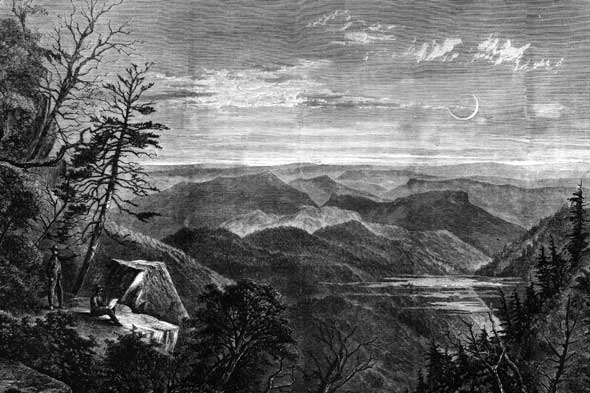
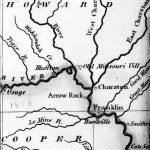
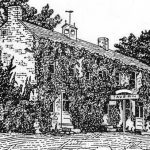

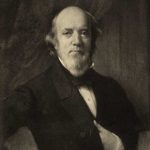
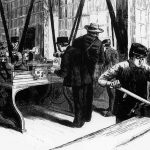
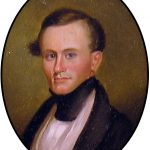
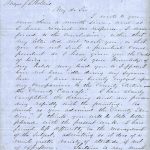
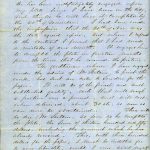
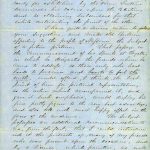
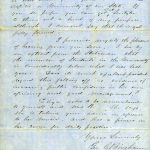
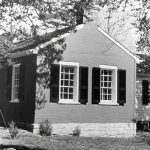
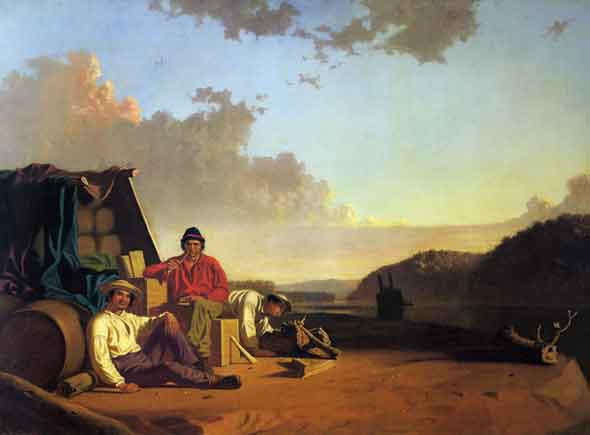
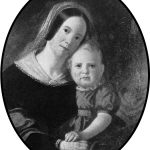
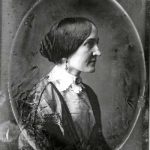
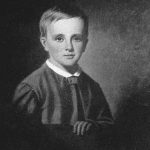
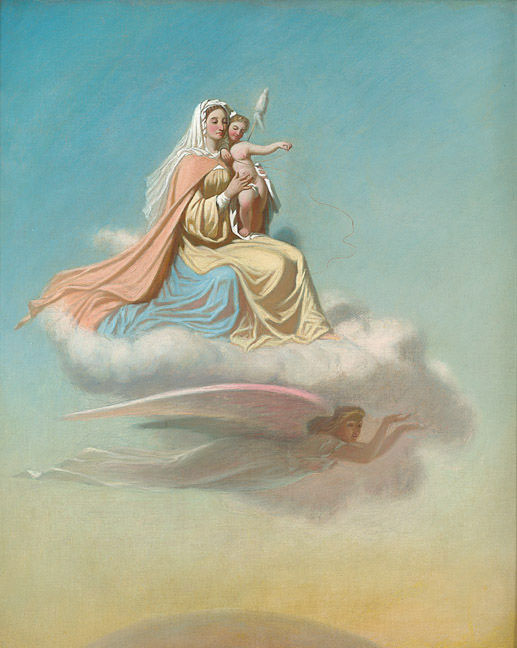
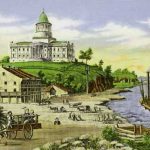

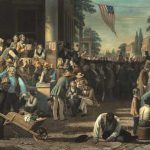

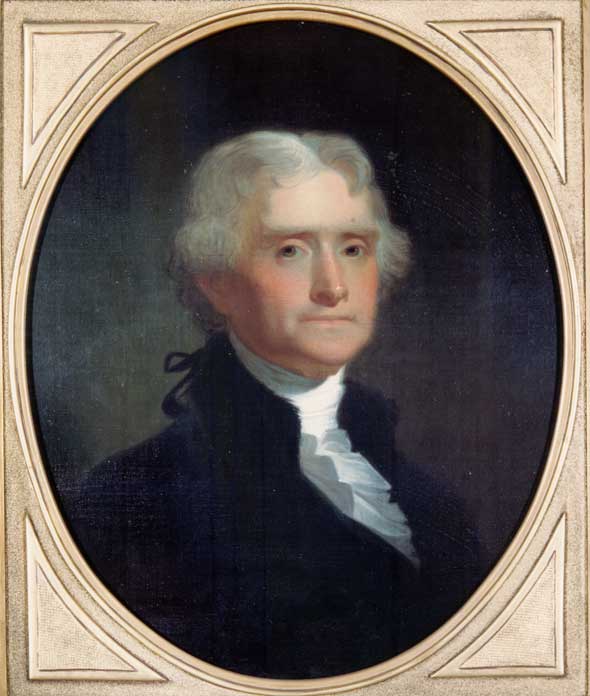
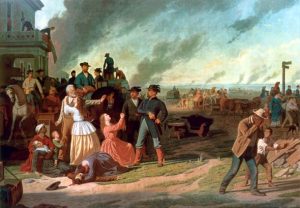 Union General Thomas Ewing Jr. issued Order No. 11 in 1863. Ewing wanted to neutralize Confederate guerrillas, so he made people who lived farther than one mile from a Union military post move. Ewing’s order affected people living in four western counties in Missouri. Bingham thought this order was unconstitutional. He found its harshness horrifying. He made up his mind to show the world Ewing’s wrongdoing on canvas.
Union General Thomas Ewing Jr. issued Order No. 11 in 1863. Ewing wanted to neutralize Confederate guerrillas, so he made people who lived farther than one mile from a Union military post move. Ewing’s order affected people living in four western counties in Missouri. Bingham thought this order was unconstitutional. He found its harshness horrifying. He made up his mind to show the world Ewing’s wrongdoing on canvas.